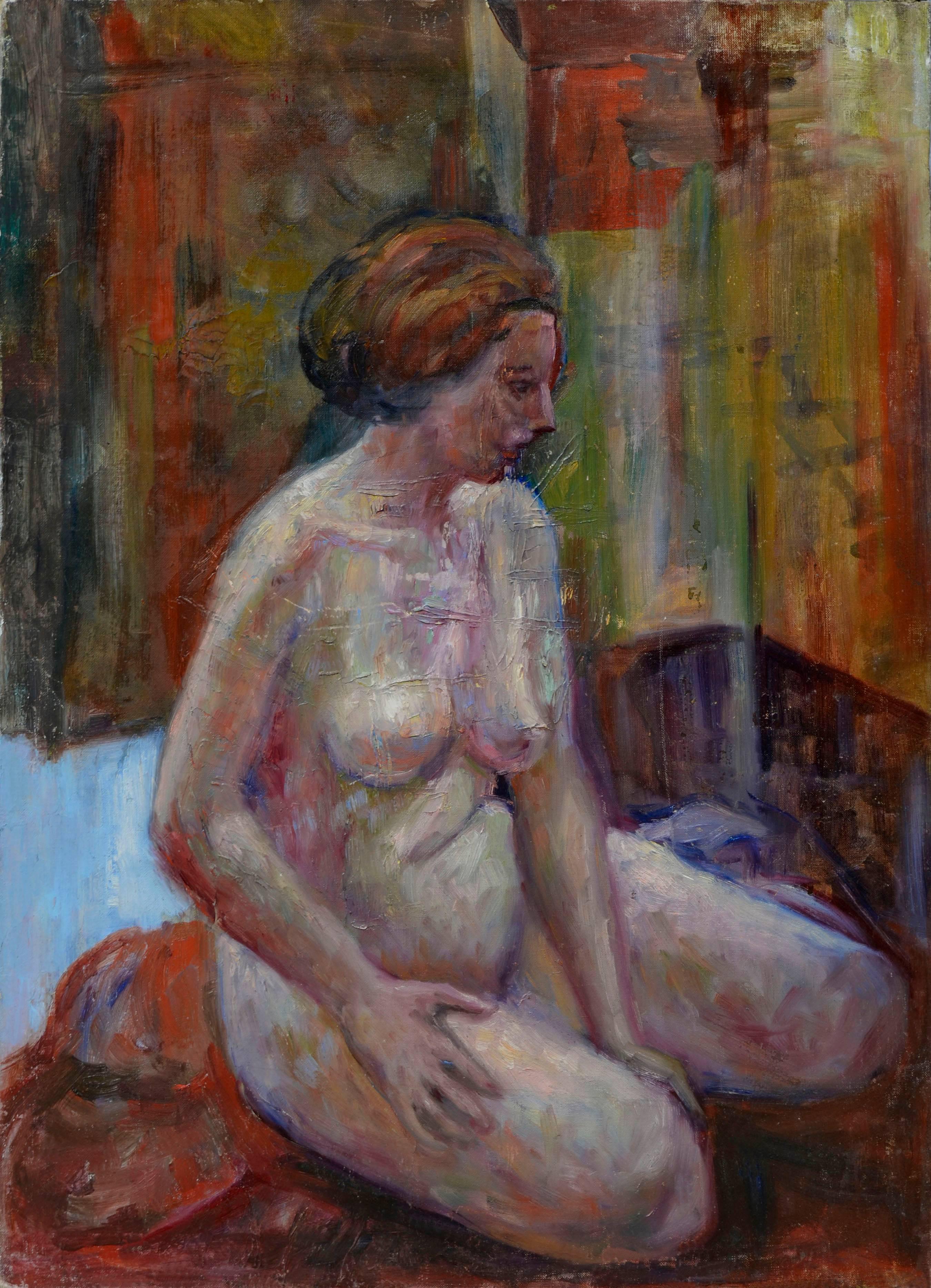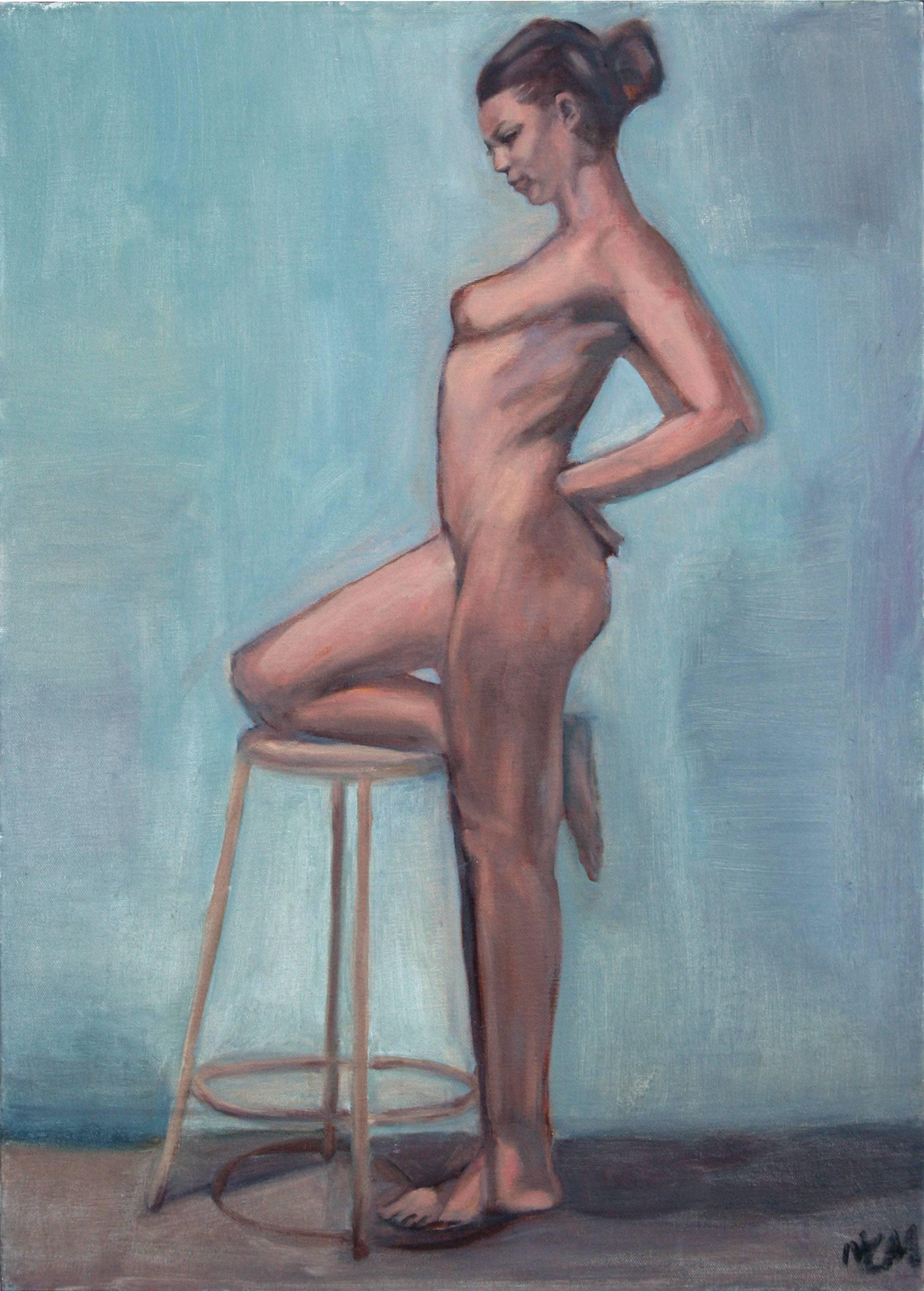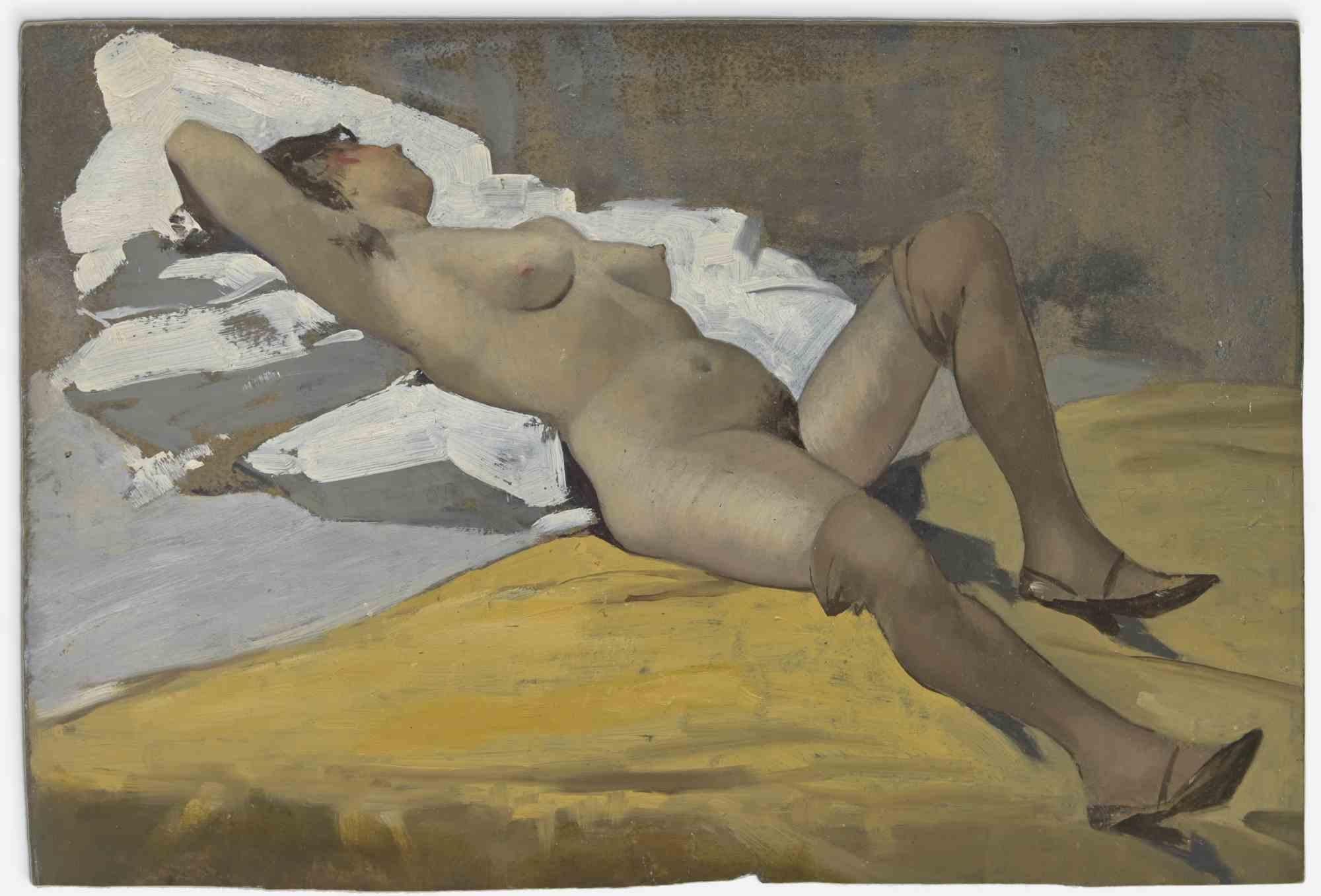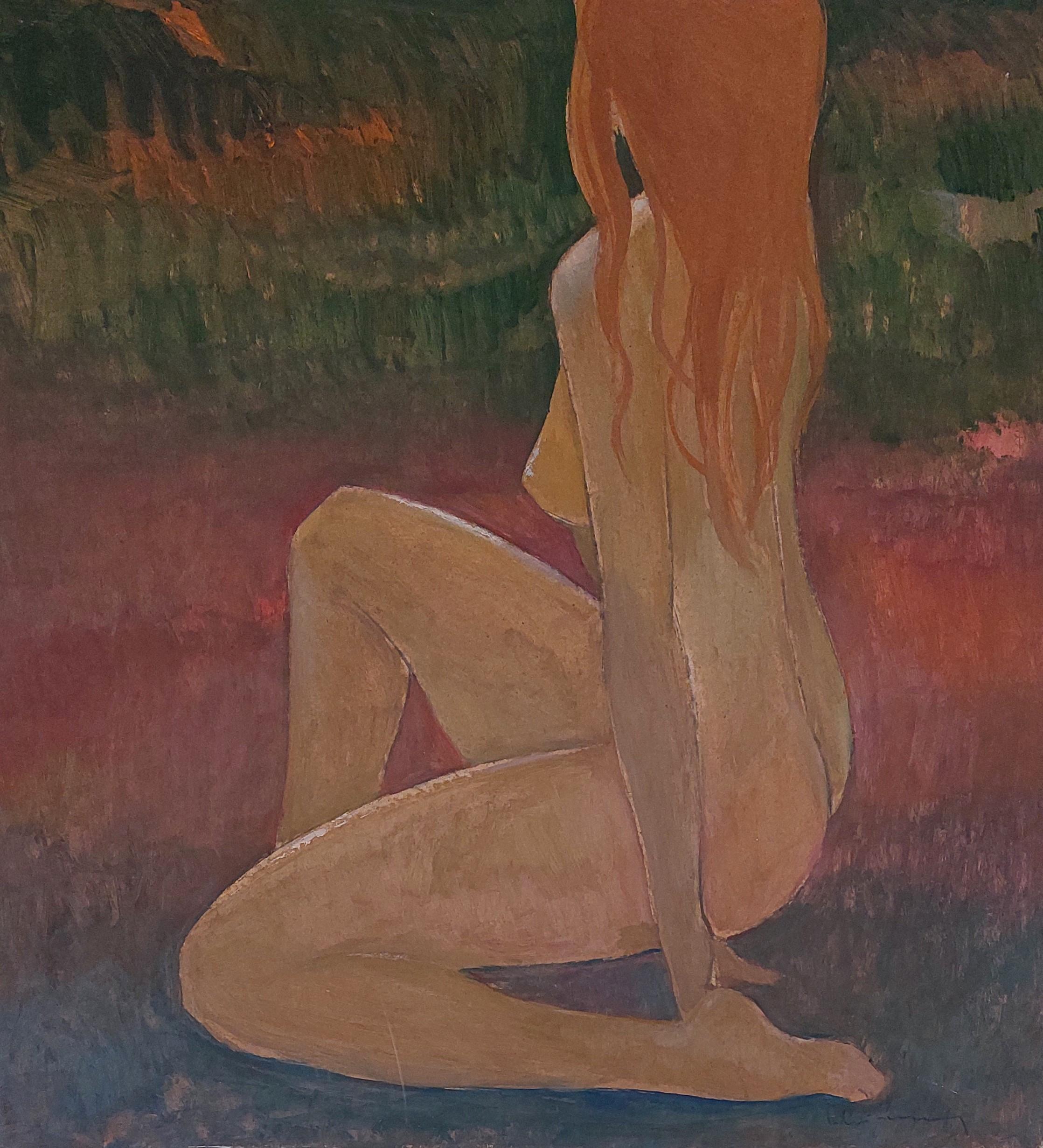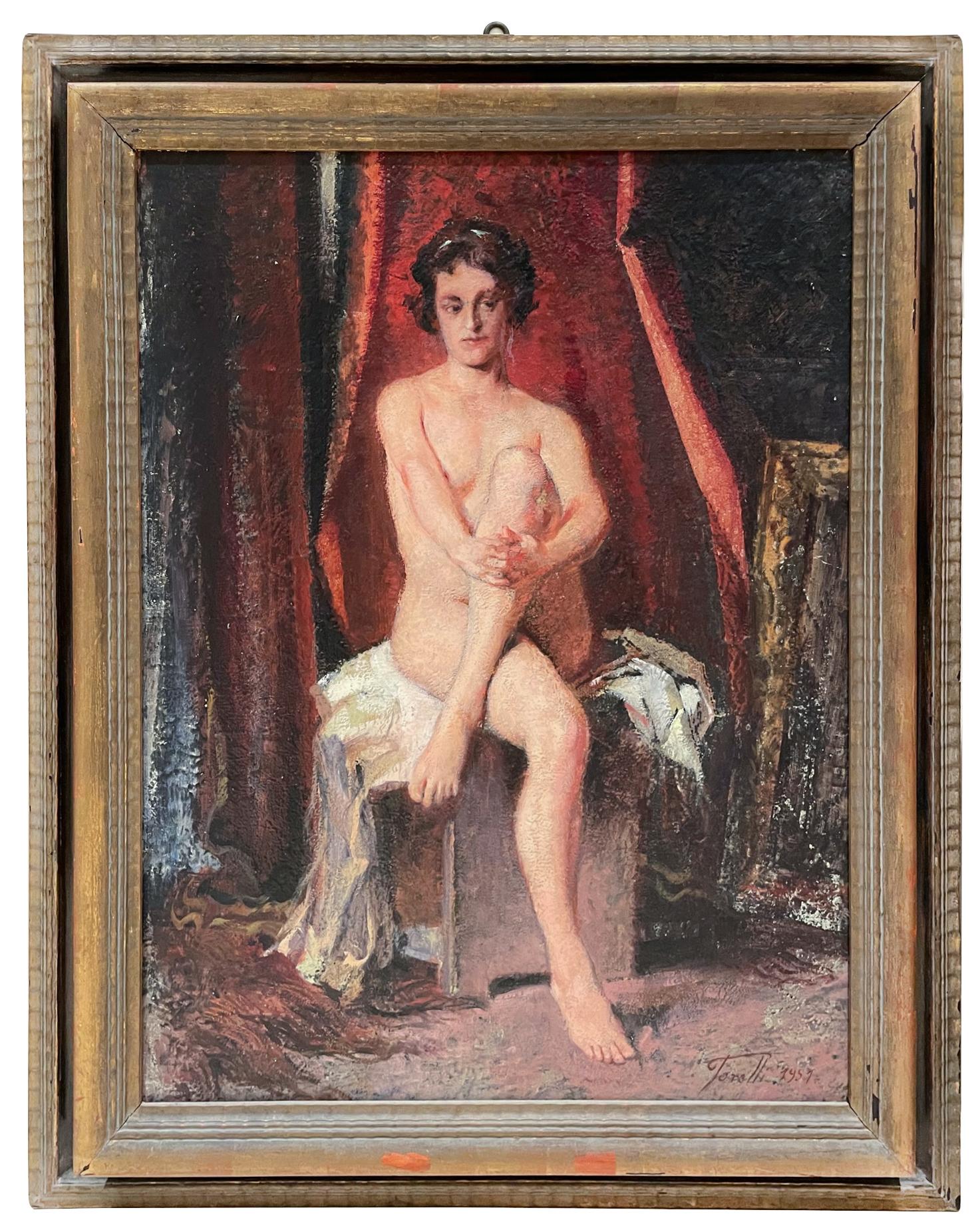Items Similar to Dreamer. 1996. Oil on cardboard, 83x90 cm
Want more images or videos?
Request additional images or videos from the seller
1 of 8
Laimdots MurnieksDreamer. 1996. Oil on cardboard, 83x90 cm1996
1996
About the Item
Dreamer. 1996. Oil on cardboard, 83x90 cm
This depiction of young nude woman lying down on green blue surface shows artist Laimdots Murnieks as a master of forms and color field areas.
Laimdots Murnieks has said: "I am a sunny artist. The sun and a woman are the center of the world. It is not for nothing that the sun always comes with me in my paintings - it is the basis of everything and symbolizes my wife - Zhanna. I think that a woman is what inspires the whole world to do good deeds. I want to express such an idea with my painting - that the good will always win, that the beautiful will always win the world. That's the main thing! Neither war nor tragedies ever impress people like that, but it is beauty that gives strength to continue working and living . I was born under the Star of Happiness - everything has been achieved. Both in art and in love."
Laimdots Murnieks (1922-2011) studied at Cesis and Jelgava teachers’ institutes (1938 – 44). He graduated from the Painting Department of the Latvian Art Academy (1953, diploma work “Winged helper”, under the guidance of V. Kozins).
He worked as a teacher in secondary schools of Valmiera and Priekuli, in agricultural technical school (1944 – 46), and in the company “Art” as a design artist (1953 – 82).
L. Murnieks takes part in exhibitions since 1953.
Solo exhibitions:
Riga – 1960, 1964, 1972 (together with I. and G. Krollis);
Liepaja – 1964;
Vilnius – 1968;
Moscow – 1968;
Rostock – 1974;
Tokyo – 1978 (together with M. Chagall).
Artist worked in different painting genres and techniques – monumental painting, easel painting; he painted landscapes, still life’s, portraits. He uses oil, pastel and tempera.
Awards:
1967 – Awarding with diploma Artists union of USSR by paintings at International exhibition “The Sport at Art”
1969 – Laureate of painting at Baltic Republications triennial
1979 - was rich of merits employee of art in Latvia Republic of Soviet Union
1969 – Award with medal
Laimdots Murnieks exhibitions of classical art gallery Antonia:
2022. 05. 26. memorial exhibition Laimdots Murnieks "Beautiful Age"
2012.10.02. - memorial exhibition “A bit of sunshine in a cold water..."
2010.03.16. - solo exhibition "Laimdots Murnieks - 88"
2008.11.22. - solo exhibition "Laimdots Mūrnieks"
2008.02.21. - solo exhibition "Cherchez la famme"
L. Murnieks works exhibited in several different classic art gallery "Antonia" organized thematic exhibitions.
- Creator:Laimdots Murnieks (1922 - 2011, Latvian)
- Creation Year:1996
- Dimensions:Height: 32.68 in (83 cm)Width: 35.44 in (90 cm)Depth: 0.12 in (3 mm)
- Medium:
- Movement & Style:
- Period:
- Condition:
- Gallery Location:Riga, LV
- Reference Number:1stDibs: LU1437210587232
About the Seller
5.0
Platinum Seller
These expertly vetted sellers are 1stDibs' most experienced sellers and are rated highest by our customers.
Established in 2002
1stDibs seller since 2020
136 sales on 1stDibs
Typical response time: 9 hours
- ShippingRetrieving quote...Ships From: Riga, Latvia
- Return PolicyA return for this item may be initiated within 7 days of delivery.
More From This SellerView All
- Girl with red hair. 1996. Oil on cardboard, 90x83 cmLocated in Riga, LVGirl with red hair. 1996. Oil on cardboard, 90x83 cm This depiction of young nude woman with red hair on green-pink-blue background shows the artist as a master of forms and color field areas. Laimdots Murnieks...Category
Late 20th Century Modern Figurative Paintings
MaterialsCardboard, Oil
- Blonde. 1996. Oil on cardboard, 83x90 cmLocated in Riga, LVBlonde. 1996. Oil on cardboard, 83x90 cm This depiction of blonde young nude woman on dark green background and turquoise color surface shows artist Laimdots Murnieks...Category
Late 20th Century Modern Figurative Paintings
MaterialsOil, Cardboard
- Morning. Women's act. 1959. Oil on cardboard, 95x71 cmBy Alfejs BromultsLocated in Riga, LVThe morning hour. Act. 1959. Oil on cardboard, 95x71 cm Alfejs Bromults (1913.3.IV - 1991.11.I) His first professional education was at National University at studies to R.Suta, J....Category
1950s Realist Nude Paintings
MaterialsCardboard, Oil
- Girl friends 2010, cardboard, author's technique, 31x21.5 cmLocated in Riga, LVGirl friends 2010, cardboard, author's technique, 31x21.5 cmCategory
2010s Impressionist Figurative Paintings
MaterialsOil, Cardboard
- Two dancers. Cardboard, oil, 34x23 cmLocated in Riga, LVTwo dancers Cardboard, oil, 34x23 cmCategory
Early 2000s Impressionist Nude Paintings
MaterialsOil, Cardboard
- Act. Double sided. cardboard, oil, 71x45 cmLocated in Riga, LVAct. Double sided. cardboard, oil, 71x45 cmCategory
1960s Impressionist Nude Paintings
MaterialsCardboard, Oil
You May Also Like
- Mid Century Sitting Nude FigurativeBy Elmer AlbrittonLocated in Soquel, CAMid Century figurative painting of a pensive sitting nude figure with moody, mid-century color palette in the background. Attributed to Elmer S. Albritton, unsigned (American, 1922-...Category
1960s American Modern Nude Paintings
MaterialsCanvas, Oil, Cardboard
- Nude Figure with StoolBy M. Z. MurphyLocated in Soquel, CAArtist's study of a model in studio by Los Gatos, California artist Maryanne Z. Murphy (American, 20th century). Signed with initials "MZM" lower right. Unframed. Image, 24"H x 18"L....Category
1990s Modern Nude Paintings
MaterialsCanvas, Cardboard, Oil
- Woman Lying Down on White Cloth - Oil Painting - Mid-20th CenturyLocated in Roma, ITWoman Lying Down on White Cloth is an artwork realized by an Italian Artist in mid-20th Century. Oil on cardboard 24x34 cm. Good conditions.Category
Mid-20th Century Modern Figurative Paintings
MaterialsCardboard, Oil
- Seated Nude - Oil Paint by Giuseppe Torelli - 1950sLocated in Roma, ITSeated Nude is an artwork realized by Giuseppe Torelli in 1950s. Oil on cardboard. 64x48 cm with frame. Handsigned in the lower right margin.Category
1950s Modern Figurative Paintings
MaterialsCardboard, Oil
- Mid Century Modern Mother and Baby Playing Figurative - NudeLocated in Soquel, CAMid Century Modern Mother and Baby Playing Figurative - Nude Wonderful small scale ink and acrylic paint of a mother and baby by Dorothea Stevenson Casady (American, 1910 - 2006). Signed lower left corner. Presented in gilt-toned and velvet filet mid-century frame. Image size: 6"H x 8.25"W Frame: 9.5"H x 11.25"W x 2.25"D (velvet liner has age toning) Casady was a painter and muralist and served as Chairman, Oklahoma City University Art Department, 1939-1943; an Art instructor, Classen High School; Education: University of Oklahoma, B.F.A., 1931; M.F.A., Norman, OK; studied with Emil Bisttram, Taos School of Art and Nan Sheets; Foundation des Etats Unis, Paris, Fance, 1935-1936; New York School of Industrial Arts; studied fresco and egg tempera under Professor Leugi Arcangeti, Florence, Italy, 1937; Oklahoma City University; Julian Academy Paris, France, 1936 Memberships: Oklahoma State Artists Association; Kappa Pi, art fraternity; Delta Delta Delta...Category
1960s Modern Figurative Paintings
MaterialsInk, Acrylic, Cardboard
- Nandor Vagh Weinmann, Oil on cardboard, Naked Back, 1930sLocated in Saint Amans des cots, FROil on cardboard by Nandor VAGH WEINMANN (1897-1978), France, 1930s. Naked back. With frame: 64x56 cm - 25.2x22 inches ; without frame: 46x38cm - 18.1x15 inches. 8F format. Signed "Nandor V. Weinmann" lower left. In its Montparnasse frame. Very good condition. Born October 3, 1897 in Budapest, Nándor is the older brother of Elemer and Maurice Vagh-Weinmann. He came to Paris to present his work in 1931. He died on December 12, 1978 near Montereau (Seine-et-Marne) following an automobile accident. He is the most colorful of the three “expressionist” brothers. Painter of figures, landscapes, especially open mountains, and bouquets in bright colors. He is also a religious painter and then finds the tragic condition. Born in BUDAPEST on October 3, 1897, Nandor Vagh Weinmann belongs to a profoundly artistic people. Living in the heart of Central Europe where they came from Asia a millennium ago, the Hungarians have preserved a strong ethnic individuality whose mark is their very synthetic, non-Indo-European language. Resistant to secular invasions, they have kept the virtues of a very ancient humanity that have become rare in our modern world, especially since their way of life has remained essentially rural until today. In the arts they know how to express a generous, extreme sensibility and by the poetic verb, by the musical rhythms and also by a popular art of a richness, an exceptional harmony. Until the age of thirty-four, during the decisive years of childhood and youth, Nandor Vagh Weinmann was intimately imbued with popular life and the soul of Hungary. From the capital where his father was a jeweler and had a family of ten children, Nandor was the fifth, he knew first of all the suburbs, the populated districts, the rigors in winter of the cold and the snow. A very mobile existence made him acquainted with all of Hungary, from the Danube to Transylvania, its infinite plains and its wild mountains, its immense villages with ample low houses, and its towns which are still immense villages. The painter is passionate about rustic works, harvest scenes, beautiful folk costumes. Coming into direct contact with the peasants, he learned to know their soul. These contacts gave the artist a direct feeling for popular life and soul, as Millet once understood the peasants of Barbizon and Normandy whose existence he shared. What fascinated Nandor Vagh Weinmann above all were the festivals which enlivened the dreary life of the countryside, the circuses, the merry-go-rounds, the gypsies unleashing orgies of music, light and color. In the party, and especially the Hungarian party, the whole soul of a people, all its energy, its need for movement, for intensity, is expressed in its pure state and realizes the primary and essential form of what is called beauty. And as if melted at the party, there is the infinite steppe where herds of horses and oxen circulate where terrible storms sometimes roar where the seasons unfold their grandiose splendours. The young Nandor Vagh Weinmann nourishes his sensitivity to his inexhaustible shows, both eternal and always new, a sensitivity which very early declared itself that of a painter. Since the age of fourteen he painted, and since then he never stopped doing it. Two of his brothers Maurice, two years his junior, who had a remarkable career similar to that of Nandor and later Elemer who became Maurice's pupil, also devoted themselves to painting, despite family obstacles. And the three brothers united by a common passion worked together in Hungary and later in France. Painting was so much in the blood of the family, as in the past among the Veroneses, the Breughels, the Lenains, the Van Loos and so many other artistic dynasties, that three sons of the Vagh Weinmanns became painters in their turn. One of these, Emeric, son of Nandor, today occupies an important place in the contemporary school. Nandor, at fifteen, was a pupil of the Academy of Fine Arts in Budapest where he worked diligently, then at that of Vienna. He painted many portraits, but also landscapes, compositions and, by his relentless work, managed to live from his brush, although married very young and having to overcome many hardships. He therefore knew the hardships and miseries of life. These strongly impregnated his vision as an artist and explain the thrill of humanity that runs through all his work. A particularly moving experience was reserved for him at the age of twenty. In the hospitals of Budapest he had to paint extraordinary cases, operations, frightful wounds, the deformations to which our poor body is subjected by traumas and physiological decompositions. In these circumstances, it is not a question of gratuitous art, of formal research but of immediate, authentic expressions of our flesh and our being. We know that Breughel Velázquez and Goya had been haunted by the sight of cripples and of madmen Géricault by that of corpses. But life is ultimately stronger than anything, and it is life that Nandor Vagh Weinmann has passionately observed and translated through all the places where he has always painted on nature. Nothing stopped him. It happened to him to paint, for example in front of the mill of Linselles by a weather so cold, that nobody could stay outside, and that he did not leave the place before having finished his work. Because he works constantly on the ground, under the sky, in the silence he loves. His reputation is established. He exhibited at the national fair in Budapest, in the big cities of Hungary Szeged, Szombathely, Veszprém, Kaposvar. In 1931, like all artists in the world, he came to France. But unlike the others, he did not settle in Paris. Because Nandor Vagh Weinmann does not belong to this group of cosmopolitans that we call the School of Paris. He settled in Toulouse, where he remained for a long time with his brothers, and traveled throughout France, eager for new ties, exhibiting in the most diverse cities, in Bordeaux, Marseille, Lyon, Agen, Bayonne, Dax, Tarbes, Grenoble, Nice, Cannes, Strasbourg, Mulhouse, Colmar, Lille. He even crossed borders. He was in Saint Sebastian, in Geneva, and once in Egypt in 1927 where he painted King Fouad...Category
1930s Expressionist Figurative Paintings
MaterialsOil, Cardboard
